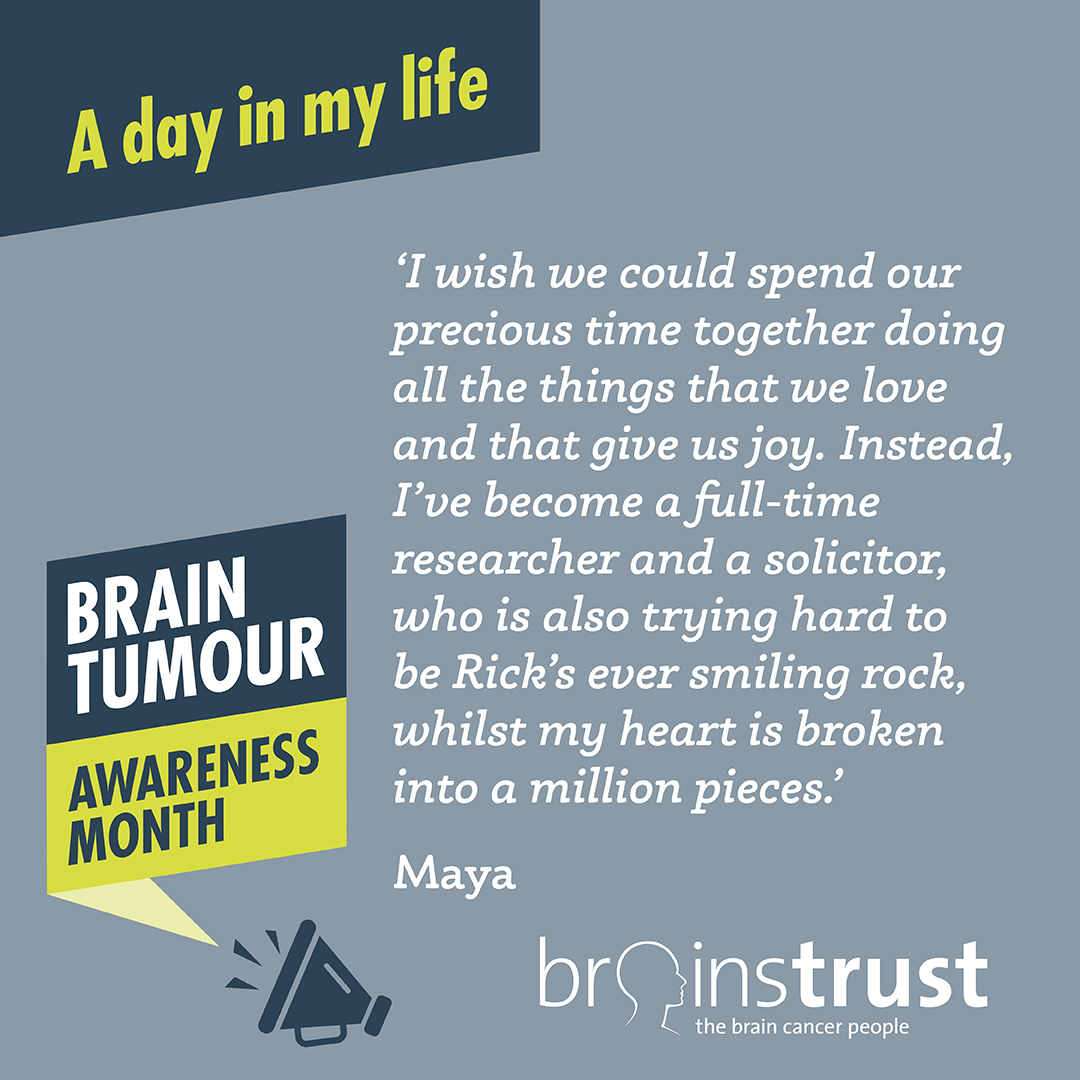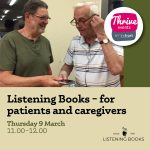 As part of our Brain Tumour Awareness Month 2023 campaign, Maya has written about a day in her life day looking after her husband who has a GBM. If Maya’s experiences resonate with you, brainstrust is here to support you. Visit our dedicated Glioblastoma hub on our website, call 01983 292 405 or email hello@brainstrust.org.uk to get support today.
As part of our Brain Tumour Awareness Month 2023 campaign, Maya has written about a day in her life day looking after her husband who has a GBM. If Maya’s experiences resonate with you, brainstrust is here to support you. Visit our dedicated Glioblastoma hub on our website, call 01983 292 405 or email hello@brainstrust.org.uk to get support today.
Maya’s day
7:45 – In my previous life I’d consider this a lie-in but today it feels like the middle of the night. The fact I was up until 2am researching more treatments for glioblastoma probably has something today with that.
9:10 – The time for Rick to have his breakfast is up. His chemo tablets must be taken on an empty stomach, meaning no food for 2 hours before. He has barely managed to touch his breakfast as he’s feeling nauseous, but I have to take it away. He looks up at me surprised – my heart breaks, for the first of many times today.
9:30 – I’m sitting at my desk to write emails to more clinics in Europe and other patients with the same condition in hope to get some reliable information about developing treatments. We’ve tried talking to NHS consultants about it, but we hit the wall of “evidence based treatments”. None of the consultants mention second opinions or recommend colleagues who are more in touch with research. It is so frustrating. Our oncologist told us with a smile on his face that there is no miracle cure for this. His conduct was so cruel and unnecessary, we could not shake it for a week. I considered making a complaint, but I decided the little energy I have is better spent on finding solutions. Rick feels bad seeing I’m putting all these hours into the research. It’s normally he who “sorts things out”. He takes his laptop and is trying to help. After 5 minutes I seen the sheer panic in his eyes, he cannot concentrate because of his debilitating brain fog induced by all the treatment. He gets really upset saying he is an imbecile and how he is supposed to go back to work, my heart breaks again.
11:10 – It is time for his chemo tablets and to leave for the hospital. He is still very upset. I’m struggling to get him out the door without rushing him – I don’t want to make him feel even worse.
12:10 – Radiotherapy done. It only takes 10 minutes, and all the staff are amazing. There’s a huge school-type bell in the waiting area, you get to ring it to mark the end of treatment and everyone claps and cheers, it’s so lovely. I ask Rick if he feels like doing something after the hospital but all he can think about is bed. At the start of the treatment we would go to a nice coffee shop to treat ourselves to lunch, go for a gentle swim or a walk. It was lovely to be able to have a nice time around the treatment – it shrunk hospital visits to a small proportion of our day. It made the time go quick. After week three of Radiotherapy/chemo the fatigue hit him hard overnight and our time is now spent between hospital and home. It seems like the treatment and the side effects will never end.
14:00 – I’m doing last minute preparations before a phone call with Dan. Dan was diagnosed with the same condition as Rick last year. We found out about him from an article in a local newspaper. Rick connected with him on Facebook and he was kind enough to agree to talk to us. From the article we understand Dan is undergoing some treatment in Germany. We are very keen to hear about it from a reliable source, as well as to speak to a “real” person in the same situation. Being affected by such a rare disease makes you feel so alone.
15:30 – The chat with Dan went really well, we talked for ages. He is very happy with his treatment and has extremely good results on it. He also recommended brainstrust – a charity which connects patients with the latest brain tumour research. This is all so positive. I’m grinning. Having a reliable source of information regarding new treatments for brain tumour would be absolutely amazing. It has taken me almost three months to get here, I feel like a criminal trying to access some illegal business. It makes me bitter and angry that our healthcare system makes it so difficult for patients in our situation to access this information.
Evening – We celebrate with a movie and delicious dinner. After all it has been a good day. In the sad world of Glioblastoma, finding people who are willing to help is like a cure on it’s own. I wish we could spend our precious time together doing all the things that we love and that give us joy. Instead, I’ve become a full-time researcher and a solicitor, who is also trying hard to be Rick’s ever smiling rock, whilst my heart is broken into a million pieces.
 Support brainstrust this Brain Tumour Awareness Month, help us give a voice to the all too often silent impact of a brain tumour by sharing these stories far and wide:
Support brainstrust this Brain Tumour Awareness Month, help us give a voice to the all too often silent impact of a brain tumour by sharing these stories far and wide:
Facebook | Instagram | Twitter | LinkedIn
We’re fundraising to help us continue our vital services. Every penny raised throughout the month will help ensure that people have the support they need to live their best life possible in the face of the life changing impact of a brain tumour diagnosis.





